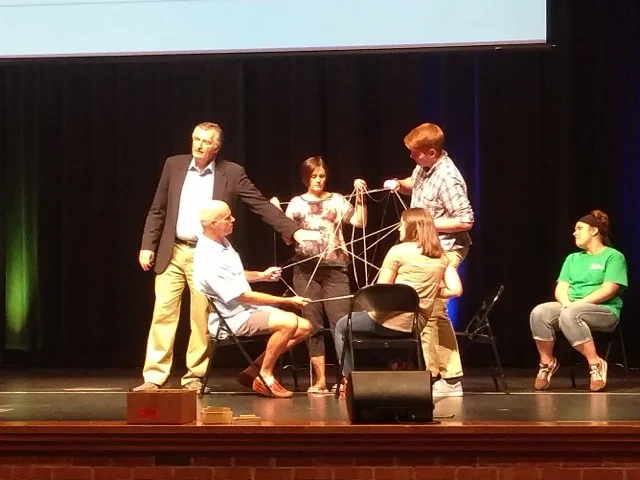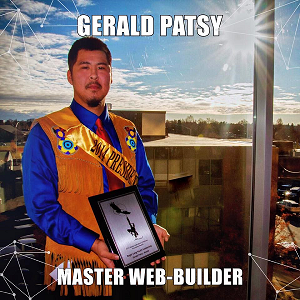
Brightway’s Blog
Articles and information about successful students, schools, families, and communities.
Youth advocate encourages webs of support to build resiliency
By Heather Lusk of Current in Zionsville
Why do some children thrive while others fail?
That was the question youth advocate Derek Peterson explored as he spoke to more than 1,500 community members over two sessions Aug. 3 after meeting with educators, Zionsville Community Schools staff and selected students.
By Heather Lusk of Current in Zionsville
Why do some children thrive while others fail?
PETERSON ILLUSTRATED A “WEB OF SUPPORT” TO HELP YOUTH THRIVE (PHOTO BY HEATHER LUSK)
That was the question youth advocate Derek Peterson explored as he spoke to more than 1,500 community members over two sessions Aug. 3 after meeting with educators, Zionsville Community Schools staff and selected students.
Peterson believes that creating a web of support for youth is a big factor, illustrating the concept by asking volunteers to act as anchors connected by crisscrossed strings to hold a balloon.
Adult anchors serve as support for each child whether they are teachers, family members, family friends, coaches or mentors. Ideally each child needs at least five caring adults in their life, Peterson said. The anchors create a web of protective factors (shown with string), whether concrete like food and a home or conceptual like courage and integrity. The balloon, or youth, won’t fall into the cracks of the web according to Peterson if they have strong support or if they “fill their balloon.”
“If you build the web of support the safety net takes care of itself,” Peterson said.
Peterson said that youth with strong webs become more resilient to social challenges and thrive in overcoming adversity and helping others.
“Your kid is more likely to thrive when they’re more connected to other people,” Peterson said. “Our data says every kid needs a personal village.”
He encouraged parents to see kids in a full spectrum of color versus the black and white of a good kid or bad kid.
“Accentuate the positive and that affects the whole color spectrum,” he said as a way to interact with teens. “Web up, because you will be more resilient if you have a web of support.”
As an expert in the field of youth development, Peterson was sponsored by ZCS as part of the Strong in Every Way initiative.
From Shy Kid to Community Leader - How PHlight Club Helped Gerald Shine
PHlight Club changed me. My web of support is stronger than ever, I am connected to people, and I feel loved and supported.
By Gerald Patsy
I was born and raised in Nulato, an Alaskan village along the Yukon river about 350 miles west of Fairbanks with a population of 270. A member of the Koyukon people, I lived with my Grandmother from the time I was four years old.
As a young child and early teenager, I was very quiet and shy. While I felt comfortable around the people I knew, I found speaking in front of strangers to be very frightening. I didn’t want to be disrespectful and I knew I needed a push to get me out of my shell. My shyness was holding me back and affecting my ability to shine.
Then in 2008, when I was in 7th grade, I had a life-altering experience. My school hosted a PHlight Club – an interactive youth leadership and empowerment experience – that required me to spend 3 days and nights away from home, participating in Connecting Activities with peers and adults. Not only was I skeptical, I was scared!
On the first day, I met Derek Peterson, the leader of PHlight Club. He was talkative and friendly and had a way of making me feel comfortable. We connected. And, through that connection, he encouraged me to join in on the activities.
By the second day, I was getting it. I surprised myself. I was learning how to create a “web of support,” comprised of at least five caring adults (Anchors) who would help me weave a strong, secure web. I learned how to identify and measure seven key factors that would help me grow and thrive. I was opening up and feeling more confident.
By the end of the third day, I saw myself and the world around me differently. I felt optimistic and resilient. I wasn’t the same shy kid I had been three days earlier. From deep inside of me, I could feel a leader emerging. I knew I wanted tocontinue being a part of PHlight Club and work with Derek, and I couldn’t wait to apply what I had learned into my everyday life.
Over the next eight years, I attended more than a dozen PHlight Clubs – first as a participant and eventually as a chaperone and then a leader. Each time, I learned something new about myself. I connected with Anchors, including Derek and my Grandma, who acted as role models to guide and support me.
I got involved in my community, taking on leadership roles in my school, region, and beyond. I became an Anchor for younger kids. I embraced my culture by working to preserve the Athabaskan language through native songs.
In March of 2014, I received the Chief Andrew Isaac Youth Leadership Award. Later that year in October, as a youth representative to the Tanana Chiefs Conference executive board I received the Alaska Federation of Natives’ Roger Lang Youth Leadership Award. Nominees for the awards had to be young men of high school age or students in college who demonstrated exceptional leadership qualities.
PHlight Club changed me. I’m now a happy 22-year-old, living and thriving in Fairbanks where I’m working full-time and planning to continue my higher education. My web of support is stronger than ever, I am connected to people, and I feel loved and supported. And, yes, I’m still a PHlight Club leader, helping other shy, timid kids to blossom.




